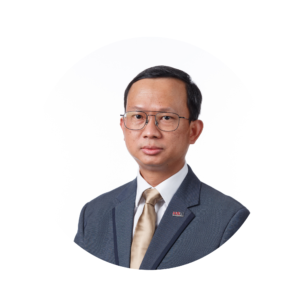Focusing on the creation, mobilisation, and realisation of innovative engineering solutions to tackle the challenges arising from the global crisis, Shaping Tomorrow: Engineering Smart Sustainable Cities at WES 2025 aims to forge new economic frontiers and unlock unprecedented opportunities in sustainability. The summit will explore critical areas where engineering can drive transformative change for a more sustainable future. Below are the key areas of focus for this conference.
TRACKS
Advancements in these areas are crucial for mitigating climate change, reducing environmental degradation, and creating a more sustainable future.
Chairperson: Dr Teo Tee Hui
Deputy Chairperson: Mr Benard Lim & Dr Lana Winayanti
Keynote Speakers:

Prof. Dr Suhono Harso Supangkat

Ir Ts Dr Bernard Lim
Vice President/Director
Appscard Group AS

Mr Felix Loh
Chief Executive Officer
Gardens by the Bay
List of sub-topics:
- Renewable Energy: The development and utilization of renewable energy sources such as solar power, wind power, hydroelectric power, geothermal energy, and bioenergy. This includes advancements in solar panels, wind turbines, energy storage solutions, and grid integration.
- Energy Efficiency: Technologies and practices aimed at reducing energy consumption and increasing efficiency. This includes energy-efficient appliances, smart grids, smart buildings, efficient transportation systems, and industrial processes.
- Circular Economy: Strategies to minimize waste generation and maximize resource efficiency. This includes recycling technologies, waste-to-energy systems, sustainable product design, and the reuse and repurposing of materials.
- Smart Cities: The integration of technology to create more sustainable and efficient urban environments. This involves smart grids, intelligent transportation systems, data-driven urban planning, energy management systems, and sustainable infrastructure development.
- Sustainable Agriculture: The use of technology to promote sustainable farming practices, reduce environmental impact, and increase productivity. This includes precision agriculture, vertical farming, aquaponics, and remote sensing for crop monitoring.
- Water Management: Technologies for efficient water use, treatment, and conservation. This includes water recycling systems, desalination techniques, water monitoring and management systems, and leak detection technologies.
- Waste Management: Innovative approaches to waste management, including waste sorting and recycling technologies, waste-to-energy conversion, composting methods, and decentralized waste management systems.
- Internet of Things (IoT) for Sustainability: Utilizing interconnected devices and sensors to optimize resource consumption, monitor environmental conditions, and enable smarter decision-making in various sectors such as energy, transportation, and waste management.
- Sustainable Materials: The development and use of eco-friendly materials with reduced environmental impact. This includes bio-based materials, biodegradable plastics, sustainable construction materials, and recycling technologies for plastic waste.
These topics highlight the multi-faceted nature of building a resilient future against climate change. They require a combination of scientific knowledge, policy frameworks, technological advancements, community engagement, and international cooperation to effectively address the challenges posed by climate change.
Chairperson: Dr Aaron Sham
Deputy Chairperson: Er. David Ng
Keynote Speakers:

Prof Chu Jian

List of sub-topics:
- Climate Adaptation: Developing strategies and implementing measures to adapt to the impacts of climate change. This includes enhancing infrastructure resilience, managing water resources, implementing coastal protection measures, and developing climate-resilient agriculture and forestry practices.
- Disaster Risk Reduction: Planning and implementing measures to reduce the risks and impacts of climate-related disasters such as floods, hurricanes, droughts, and wildfires. This includes early warning systems, improved emergency response, resilient building design, and community preparedness.
- Ecosystem Conservation and Restoration: Protecting and restoring ecosystems such as forests, wetlands, and coral reefs, which provide natural buffers against climate change impacts. This includes reforestation efforts, conservation of biodiversity, sustainable land management practices, and the creation of protected areas.
- Sustainable Urban Planning: Designing cities and urban areas that are resilient to climate change. This includes integrating green infrastructure, promoting compact and walkable communities, enhancing public transportation, improving stormwater management, and implementing climate-responsive building codes.
- Climate-Resilient Agriculture: Developing agricultural practices that are adaptive to climate change, such as drought-resistant crop varieties, efficient irrigation systems, agroforestry techniques, and soil conservation methods.
- Resilient Infrastructure: Building and upgrading infrastructure systems that can withstand climate change impacts. This includes designing resilient buildings, constructing climate-resilient transportation networks, developing robust energy systems, and ensuring reliable water and sanitation infrastructure.
- Financial Resilience: Developing financial mechanisms and strategies to support climate resilience. This includes climate risk assessments, insurance products for climate-related risks, innovative financing mechanisms for adaptation projects, and promoting climate-resilient investments.
- Community Engagement and Social Resilience: Empowering communities to become more resilient to climate change impacts. This includes promoting community-based adaptation approaches, enhancing social cohesion, supporting vulnerable populations, and integrating local knowledge and practices into resilience-building efforts.
- Technology and Innovation: Harnessing technology and innovation to build resilience against climate change. This includes the development of climate modeling and forecasting tools, early warning systems, climate-smart technologies for agriculture and energy, and innovative solutions for climate adaptation and mitigation.
- International Cooperation: Fostering collaboration among nations to address climate change and build resilience globally. This includes sharing knowledge and best practices, providing financial and technical support to developing countries, and implementing international agreements such as the Paris Agreement.
These topics highlight the diverse aspects of industry sustainability, with a focus on reducing environmental impact, optimizing resource use, and fostering social responsibility within industrial sectors. By addressing these topics, industries can contribute to a more sustainable and resilient future.
Chairperson: Ms Wan Siew-Ping
Deputy Chairperson: Mr Soh Tiam Chwee
Keynote Speakers:

Dr Ronny Sondjaja
Research, Development & Innovation – Region Asia Pacific

Er. Lucas Ng HK
Head, Sustainability
PCS Pte. Ltd.
List of sub-topics:
- Sustainable Manufacturing: Implementing cleaner production methods, resource efficiency, and circular economy principles in manufacturing processes. This includes reducing energy consumption, minimizing waste generation, implementing sustainable supply chain practices, and utilizing eco-friendly materials.
- Green Technologies: Developing and adopting innovative technologies that enable sustainable industrial practices. This includes advancements in clean energy technologies, pollution control and abatement systems, sustainable materials, and digitalization for resource optimization.
- Sustainable Supply Chains: Promoting sustainable practices throughout the supply chain, including responsible sourcing, ethical labor practices, and reducing carbon emissions. This involves implementing transparency, traceability, and certification mechanisms, and collaborating with suppliers to ensure sustainability standards are met.
- Industrial Ecology: Applying principles of ecological systems to industrial processes, aiming for a closed-loop system where waste from one process becomes a resource for another. This includes industrial symbiosis, where the waste or byproducts of one industry are utilized as raw materials by another.
- Decentralized and Distributed Production: Shifting towards localized production systems that reduce transportation and energy needs. This includes concepts such as distributed energy generation (e.g., rooftop solar panels), local manufacturing hubs, and 3D printing technologies that enable on-demand production.
- Sustainable Product Design: Incorporating sustainability considerations throughout the product lifecycle, from design to disposal. This includes concepts such as eco-design, life cycle assessment, product durability, recyclability, and use of environmentally friendly materials.
- Industrial Energy Efficiency: Implementing energy-efficient technologies and practices to reduce energy consumption in industrial processes. This includes energy management systems, process optimization, waste heat recovery, and energy-efficient equipment.
- Water and Resource Management: Implementing strategies to optimize water and resource use in industrial operations. This includes water recycling and reuse systems, responsible water sourcing, and minimizing the use of scarce resources.
- Social Responsibility and Stakeholder Engagement: Focusing on the social aspects of sustainability within industries. This includes fair labor practices, employee welfare, community engagement, and responsible corporate governance.
- Policy and Regulation: Developing and enforcing policies and regulations that incentivize and regulate sustainable practices within industries. This includes carbon pricing mechanisms, environmental standards, eco-labeling, and green procurement policies.
These topics highlight the key aspects of smart and sustainable urban mobility, aiming to create more efficient, accessible, and environmentally friendly transportation systems in cities. By addressing these topics, cities can improve quality of life, reduce traffic congestion, and mitigate the environmental impact of transportation.
Chairperson: Mr Lew Yii Der
Deputy Chairperson: Dr Zheng Jianxin
Keynote Speakers:


List of sub-topics:
- Public Transportation Systems: Enhancing and expanding public transportation networks, including buses, trams, light rail, and subways. This involves improving connectivity, increasing frequency, integrating real-time information systems, and implementing smart fare payment systems.
- Active Transportation: Promoting walking, cycling, and other non-motorized modes of transportation. This includes developing safe and accessible pedestrian and cycling infrastructure, implementing bike-sharing programs, and creating pedestrian-friendly urban spaces.
- Electric and Low-Emission Vehicles: Encouraging the adoption of electric vehicles (EVs) and other low-emission vehicles for personal and public transportation. This involves establishing EV charging infrastructure, providing incentives for electric vehicle ownership, and supporting the development of electric public transportation fleets.
- Mobility as a Service (MaaS): Integrating various modes of transportation into a seamless and user-friendly mobility platform. This includes smartphone apps that provide information, booking, and payment services for multiple transportation options, such as public transit, ridesharing, bikesharing, and carpooling.
- Intelligent Transportation Systems (ITS): Utilizing advanced technologies to optimize traffic flow and enhance transportation efficiency. This includes traffic management systems, adaptive traffic signal control, real-time traveler information, and intelligent parking systems.
- Urban Freight and Logistics: Improving the efficiency and sustainability of goods movement within cities. This involves implementing last-mile delivery solutions, optimizing logistics networks, promoting electric and low-emission freight vehicles, and encouraging off-peak deliveries.
- Data Analytics and Predictive Modeling: Leveraging data to improve decision-making and optimize transportation systems. This includes analyzing transportation patterns, predicting travel demand, identifying congestion hotspots, and optimizing route planning.
- Integrated Land Use and Transportation Planning: Promoting compact and mixed-use development that reduces the need for long-distance commuting and supports walkability and accessibility to public transportation. This involves coordinating land use and transportation planning efforts to create sustainable urban environments.
- Green Transportation: Innovations in transportation that promote sustainability, such as electric vehicles (EVs), hybrid vehicles, fuel-efficient engines, and public transportation systems. This also includes the development of infrastructure for EV charging stations.
The built environment can contribute to a more sustainable future by reducing energy consumption, minimizing environmental impact, promoting resource efficiency, and improving occupant well-being.
Creating a greener and renewable built environment involves various topics related to sustainable design, construction, and operation of buildings and infrastructure.
Chairperson: Er. David Ng
Deputy Chairperson: Dr Aaron Sham
Keynote Speakers:

Senior Scientist
Pan-United Concrete Pte Ltd



List of sub-topics:
- Energy-Efficient Building Design: Incorporating energy-efficient design principles into buildings, including passive design strategies, proper insulation, high-performance windows, and efficient HVAC systems. This aims to minimize energy consumption and reduce greenhouse gas emissions.
- Renewable Energy Integration: Integrating renewable energy systems into buildings and infrastructure, such as solar photovoltaic (PV) panels, wind turbines, and geothermal systems. This includes on-site renewable energy generation and grid integration to maximize renewable energy utilization.
- Green Building Certification: Implementing green building rating systems and certifications, such as LEED (Leadership in Energy and Environmental Design) or BREEAM (Building Research Establishment Environmental Assessment Method). This ensures that buildings meet specific sustainability criteria in areas like energy efficiency, water conservation, indoor environmental quality, and materials selection.
- Sustainable Materials and Construction: Using environmentally friendly and sustainable materials in construction, such as recycled content, low-VOC (volatile organic compounds) products, and sustainably sourced timber. Implementing construction practices that minimize waste generation and promote resource efficiency.
- Water Efficiency and Conservation: Incorporating water-efficient fixtures, rainwater harvesting systems, greywater recycling, and efficient irrigation practices in landscaping. This reduces water consumption and promotes sustainable water management in the built environment.
- Green Roofs and Living Walls: Implementing vegetated roofs and walls that provide multiple benefits, including insulation, stormwater management, biodiversity promotion, and urban heat island reduction. These features enhance the ecological footprint of buildings and improve air quality.
- Smart Building Technologies: Utilizing advanced technologies for monitoring and optimizing building performance, including smart meters, building automation systems, and energy management software. This allows for real-time energy monitoring, efficient resource allocation, and better occupant comfort.
- Sustainable Urban Planning: Incorporating sustainable design and land-use planning principles into urban development. This includes promoting mixed-use developments, walkability, bike-friendly infrastructure, and access to public transportation to reduce the environmental impact of urban areas.
- Circular Economy in Construction: Embracing the principles of the circular economy by promoting material reuse, recycling, and repurposing. This involves adopting deconstruction practices instead of demolition, using reclaimed materials, and designing buildings for disassembly and future adaptability.
- Net-Zero Energy and Zero-Emission Buildings: Designing and constructing buildings that generate as much energy as they consume (net-zero energy) or produce no greenhouse gas emissions during operation (zero-emission). This requires a combination of energy-efficient design, renewable energy integration, and advanced building systems.
